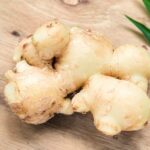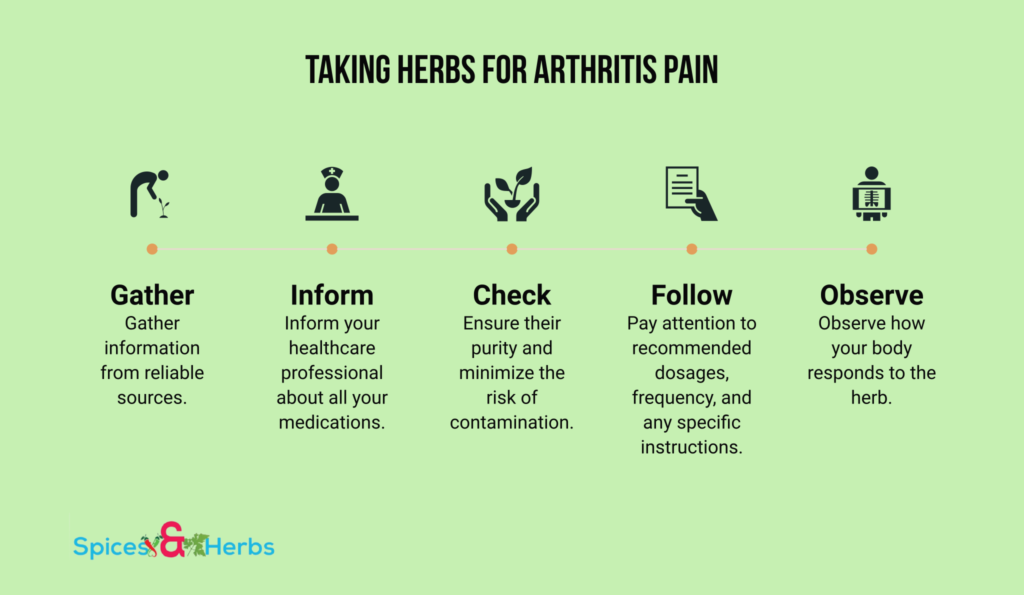Are you tired of the constant ache and stiffness caused by arthritis? Do you dream of finding a natural remedy that can offer relief without the side effects of medications? Well, get ready to be amazed by the herbs that can help with arthritis pain!
Arthritis, a condition that affects people of all ages, can be a debilitating experience, hindering our daily activities and dampening our spirits. While traditional treatments have their place, the allure of natural solutions has captivated the attention of countless individuals seeking a more holistic approach. And guess what? Herbs have emerged as the superheroes of pain management, possessing remarkable anti-inflammatory properties and the potential to set you free from discomfort.
So keep reading to learn more!
Usage of Herbs for Arthritis Pain (From Ancient Period to Modern Times)

The usage of herbs for arthritis pain relief has a long history that spans different cultures and time periods. While it’s important to note that herbal remedies should not replace medical advice, many people have turned to herbs to alleviate symptoms and support overall joint health. Here’s a brief overview of the history of herbal usage for arthritis pain:
Ancient Civilizations
- Traditional Chinese Medicine (TCM): TCM has a history of over 2,000 years and utilizes various herbs for treating arthritis. Chinese herbal formulas like Du Huo Ji Sheng Tang and Eucommia Bark have been used to address joint pain and inflammation.
- Ayurveda: Ayurvedic medicine, originating in ancient India, employs a holistic approach to health. Herbs like Boswellia serrata (Indian frankincense) and Turmeric (Curcuma longa) have been used in Ayurveda for their anti-inflammatory properties and to promote joint health.
Medieval and Renaissance Periods
- European Herbalism: During the medieval and Renaissance periods, European herbalists focused on herbal remedies for various ailments, including arthritis. Herbs such as Willow bark (Salix spp.), which contains salicin (a compound similar to aspirin), were used to relieve pain and inflammation.
- Native American Herbalism: Native American tribes developed their own herbal practices. For instance, the Cherokee tribe used herbs like Devil’s Claw (Harpagophytum procumbens) and Yucca root (Yucca spp.) to address joint pain.
Modern Times
- Traditional Systems: Traditional herbal systems, such as TCM and Ayurveda, continue to be practiced and have gained recognition in many parts of the world. Various herbal formulations, including combinations of herbs like ginger, turmeric, and licorice, are used to support joint health and manage arthritis symptoms.
- Scientific Research: With advancements in scientific research, there has been an increased interest in studying the effectiveness of herbs for arthritis. Some herbs like Turmeric (containing curcumin) and Ginger have shown promising results in reducing inflammation and providing pain relief in certain studies.
Top 5 Herbs For Arthritis Pain
🟩 Turmeric

Turmeric, a yellow spice commonly used in Indian cuisine, contains a chemical compound called curcumin, which is believed to have anti-inflammatory and antioxidant properties. Many studies have suggested that curcumin may provide several benefits for individuals with arthritis pain.
Here’s how turmeric, specifically curcumin, may help with arthritis pain:
✓ Anti-inflammatory effects
Inflammation is the bad guy behind joint pain and swelling in arthritis. Curcumin swoops in and takes down those pesky molecules that cause inflammation, bringing relief to your achy joints.
✓ Pain relief
Turmeric’s curcumin has another awesome power – it can zap away the pain! It blocks the production of pain-causing molecules and messengers, acting like a natural painkiller for your joints.
✓ Antioxidant properties
Arthritis villains create oxidative stress and harmful molecules called reactive oxygen species. But fear not! Curcumin steps in as an antioxidant superhero, neutralizing those nasty molecules and reducing the stress on your joints.
✓ Modulation of immune response
In certain types of arthritis, like rheumatoid arthritis, the immune system goes a bit haywire. Curcumin acts as a wise guardian, calming down the overactive immune response, and protecting your joints from further damage.
✓ Cartilage protection
Your joints have a protective cushion called cartilage. Curcumin comes to the rescue by preventing the destruction of cartilage and helping to rebuild and maintain its health.
✓ Enhanced drug effectiveness
Curcumin doesn’t work alone. It can boost the power of other arthritis medications you might be taking, like nonsteroidal anti-inflammatory drugs (NSAIDs), making them even more effective in fighting pain and inflammation.
🟩 Ginger

Ginger is a popular natural remedy that has been used for centuries to alleviate various ailments, including arthritis pain. While it may not provide a complete cure for arthritis, some research suggests that ginger may offer certain benefits in reducing inflammation and relieving pain associated with arthritis.
Here’s what you should know:
✓ Anti-inflammatory properties
Ginger contains compounds called gingerols and shogaols, which have anti-inflammatory effects. Inflammation plays a significant role in arthritis pain, so ginger’s anti-inflammatory properties may help reduce pain and swelling.
✓ Pain relief
Ginger may act as a natural analgesic and provide pain relief. Some studies suggest that ginger can inhibit pain-causing chemicals in the body and reduce the perception of pain.
✓ Improved mobility
Arthritis pain often limits joint mobility. Preliminary research indicates that ginger may enhance joint flexibility and movement, thereby improving mobility in individuals with arthritis.
✓ Potential reduction of medication use
While ginger cannot replace prescribed medications for arthritis, some people find that incorporating ginger into their routine may help reduce their reliance on pain medications. However, always consult with your healthcare provider before making any changes to your medication regimen.
🟩 Boswellia

Have you heard about Boswellia? It’s a natural supplement made from the resin of the Boswellia serrata tree, also known as Indian frankincense. People have been using it for ages to help with arthritis pain.
The cool thing about Boswellia is that it has these special compounds called boswellic acids. These acids have been shown to reduce inflammation, which is a big factor in arthritis pain. By fighting inflammation, Boswellia may help ease your joint pain and make it easier for you to move around.
Some studies have looked into Boswellia for arthritis, and the results are looking pretty good. They found that it can help reduce pain, improve how your joints work, and even lower the levels of inflammation in your body. It might also help you cut back on other medications you’re taking for arthritis.
🟩 Willow bark

Willow bark has been used for centuries as a natural way to relieve pain. Willow bark contains a compound called salicin, which is similar to the active ingredient in aspirin. This compound has anti-inflammatory and pain-relieving properties that can help reduce arthritis pain and inflammation.
Some studies have looked into how effective willow bark is for arthritis pain, and the results are a bit mixed. But, it seems to provide mild to moderate pain relief for people with arthritis, including osteoarthritis and rheumatoid arthritis.
Now, keep in mind that willow bark might not work as quickly or strongly as medications made specifically for arthritis pain. And not all willow bark products are the same, so it’s important to choose a reliable brand if you decide to try it.
Before giving it a shot, it’s a good idea to talk to your doctor or healthcare provider. They can give you personalized advice and make sure it’s safe for you, especially if you have other health conditions or take other medications.
🟩 Devil’s claw

So, you’ve heard about devil’s claw for arthritis pain, huh? Well, devil’s claw is an herbal supplement that people have been using for centuries to tame those pesky arthritis pains.
Picture this: deep in the heart of Africa, there’s a plant called Harpagophytum procumbens, and it’s got some magic in its roots. Those roots are where the devil’s claw comes from, and it’s packed with special compounds called harpagosides. These harpagosides are like little warriors against inflammation, which is often the culprit behind arthritis pain.
Now, here’s the catch: while some studies suggest that devil’s claw can help with arthritis pain and make you feel a bit better, others aren’t so sure. It’s a bit like a coin toss, sometimes it works, sometimes it doesn’t. Scientists are still trying to figure out the full story.
Oh, and one more thing to keep in mind is that not all devil’s claw supplements are created equal. They can vary in strength and quality, so it’s important to talk to your friendly healthcare provider before diving in. They’ll make sure devil’s claw won’t clash with any other medications you’re taking or any conditions you might have.
Dos and Don’ts When Taking Herbs for Arthritis Pain
While herbs can offer relief to some, it’s essential to navigate this green terrain with caution and wisdom. Consider these dos and don’ts to make your herbal journey as successful and enjoyable as possible:
🟦 What to do
- Consult with a healthcare professional: Before starting any herbal treatment, consult with your healthcare provider or a qualified herbalist who can provide guidance based on your specific health condition, medications, and potential interactions.
- Research and choose reputable sources: Gather information from credible sources such as scientific research, reputable herbal medicine books, and trusted websites. Look for evidence-based studies on the effectiveness and safety of the herbs you’re considering.
- Start with small doses: Begin with a low dosage of the herb and monitor your body’s response. This helps you identify any adverse reactions or allergies.
- Maintain open communication with your doctor: Inform your healthcare provider about the herbs you’re taking. They can monitor your progress, provide guidance, and identify any potential interactions with other medications you may be using.
- Follow recommended guidelines: If you decide to take an herbal supplement, carefully follow the instructions on the packaging or as recommended by your healthcare provider or herbalist.
🟦 What not to do
- Rely solely on herbs for treatment: Arthritis is a complex condition, and its management often requires a comprehensive approach. Don’t rely solely on herbs; instead, consider them as part of an overall treatment plan that may include medication, exercise, physical therapy, and other interventions.
- Assume all herbs are safe: Not all herbs are safe for everyone or suitable for arthritis pain. Some herbs may interact with medications, worsen certain health conditions, or have side effects. It’s crucial to be aware of any potential risks and consult a professional before use.
- Discontinue prescribed medications: Never stop or modify your prescribed medications without consulting your doctor, even if you decide to try herbal remedies. Some herbs can interact with medications and may require adjustments in your treatment plan.
- Overuse or misuse of herbs: Just like medications, herbs should be used in moderation and according to recommended guidelines. Avoid exceeding the recommended dosage, as it can lead to adverse effects.
- Disregard your body’s response: Pay attention to any changes or adverse reactions when taking herbs. If you experience any unexpected symptoms or worsening of your condition, discontinue use and consult a healthcare professional.
How to Take Herbs Safely for Arthritis Pain

When considering using herbs for arthritis pain, it’s important to prioritize safety. When choosing herbs, gather information from reliable sources such as scientific studies, reputable websites, or books written by experts in herbal medicine. Be cautious of unsubstantiated claims or anecdotal evidence. Some herbs can also interact with medications, causing adverse effects or reducing their effectiveness. Inform your healthcare professional about all the medications, supplements, and herbs you are taking to avoid any potential interactions.
Another factor is to choose high-quality herbs from reputable sources to ensure their purity and minimize the risk of contamination. Look for standardized herbal extracts when possible, as they may provide more consistent dosages. Read and follow the instructions on the herb’s packaging or the advice given by your healthcare professional. Pay attention to recommended dosages, frequency, and any specific instructions for preparation or consumption.
Lastly, observe how your body responds to the herb. If you experience any adverse effects or discomfort, discontinue use and consult your healthcare professional.
Final Words
In conclusion, the use of herbs for arthritis pain relief offers a natural and holistic approach that can complement conventional treatments and improve the overall well-being of individuals suffering from arthritis. While research on herbs is ongoing, the evidence thus far indicates their potential in reducing inflammation, alleviating pain, and promoting joint health.
Remember, herbs should not be viewed as standalone treatments, but rather as part of a comprehensive management plan that includes regular exercise, a healthy diet, and communication with your healthcare provider. It’s essential to approach herbal remedies with caution, ensuring proper dosage, and being aware of any potential interactions with medications.
By incorporating herbs into your daily routine, you may experience a reduction in arthritis symptoms, increased mobility, and improved quality of life. From well-known herbs like turmeric and ginger to lesser-known gems like Boswellia and devil’s claw, the world of herbal remedies offers a diverse range of options to explore.
Have a healthy day!

